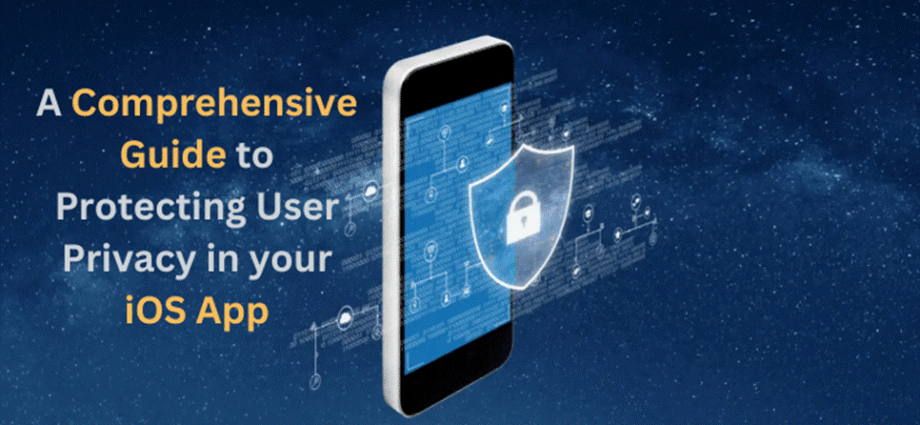iOS stands out as a popular operating system for its renowned security measures, attributed to Apple’s stringent restrictions like rigorous code reviews, limited access to device resources, and a carefully curated App Store approval process. The perception that iOS is one of the most secure platforms should not, however, lead developers into a false sense of complacency. With the growing emphasis on data security and privacy from users, businesses, and regulatory bodies, iOS app developers need to go beyond the perceived invincibility of iOS and proactively address security concerns in their applications.
In this blog post, we will delve into the best practices to protect user privacy during iOS application development to ensure a secure and trustworthy user experience.
Potential reasons that lead to user privacy threats:
As iOS app developers create innovative applications, they must be vigilant in identifying and mitigating potential threats that could compromise sensitive user information. Here are a few reasons that pose a threat to user privacy in applications run on Apple devices.
● Insecure data transmission:
During insecure data transmission, information exchanged between the app and its servers could be intercepted by malicious actors. This may lead to the exposure of sensitive user data, potentially resulting in privacy breaches and unauthorized access.
● Insufficient data encryption:
Encryption acts as a safeguard, rendering the data unreadable without the appropriate decryption keys. Without proper encryption, stored user data becomes vulnerable. If an unauthorized party gains access to the storage, they can retrieve and potentially misuse sensitive information.
● Poorly managed user authentication:
Weak user authentication mechanisms create an opening for unauthorized access. If user accounts are not secured through strong authentication methods, malicious actors could gain entry, compromising the privacy and security of user accounts and associated data.
● Inadequate session management:
Improper session management could lead to sessions being hijacked, allowing unauthorized users to gain access to an authenticated user’s account. This leads to granting unauthorized control (hijacking) over active sessions which poses a significant risk to user privacy.
●Location tracking concerns:
Location tracking poses a privacy risk when GPS trackers are employed without appropriate consent or safety measures. When an app inappropriately accesses or records location data without explicit user approval or for purposes unrelated to its core functionality, it can raise concerns about privacy infringement and compromise personal safety. The extent to which such tracking is deemed excessive should be defined based on transparent and user-friendly consent mechanisms.
Best practices for iOS app developers to safeguard user privacy:
Below are some of the best practices that iOS app developers and owners should adopt to fortify user privacy within their iOS applications.
1. Adhere to data minimization and purpose limitation:
Data minimization and purpose limitation are foundational principles in ensuring the security of user information within your iOS app. They emphasize collecting only essential data for the app’s functionality and ensuring that each piece of data has a clearly defined and legitimate purpose. By following these guidelines, an iOS app developer not only reduces the risk of data breaches but also complies with global privacy regulations.
2. Establish transparent privacy policies:
Every iOS app should have a clear and concise privacy policy accessible to users. Your privacy policy is a contract between you and your users, outlining what data you collect, how it is used, and how it is protected. Ensure that your privacy policy is written in plain language, avoiding legal jargon that might confuse users. Regularly update the policy to reflect any changes in data handling practices and notify users about these updates.
3. Obtain user consent:
User consent and opt-in mechanisms are fundamental to ethical data processing. To ensure a clear understanding and voluntary agreement from users to share their information, it is crucial to implement a transparent and user-friendly consent mechanism. This involves providing users with comprehensible information about what data is being collected, why it is necessary, and for what purposes. Opt-in mechanisms, where users actively choose to share their data, are preferred over opt-out approaches. This preference is rooted in the idea that opt-in approaches empower users with a choice in sharing their information, aligning with a more transparent and user-centric approach to data collection. Implement the following key practices for user consent:
- Clearly explain what data will be collected, why it is needed, and how it will be used. Use a simple and direct tone that is easily understandable by any user.
- When your app collects different types of data for various purposes, provide users with granular control over what they are comfortable sharing. This allows for a more personalized and transparent user experience.
- Users should have the ability to revoke their consent at any time. Implement mechanisms that allow users to easily withdraw their consent and have their data deleted if they choose to do so.
- Maintain records of user consent. Having a documented trail of when and how users provided consent can be valuable in demonstrating compliance with privacy regulations.
4. Use secure data transmission protocols:
When data is transmitted between the app and your servers, ensure it is encrypted using secure protocols such as TLS (Transport Layer Security). This prevents unauthorized access to sensitive information during the transmission process. Regularly update and patch your encryption protocols to mitigate potential vulnerabilities. Always keep your SSL/TLS certificates up-to-date and follow the latest encryption standards to maintain a secure communication channel.
5. Define data retention policies:
To specify how long user data will be stored and the purposes for which it will be used you must define clear data retention policies. Avoid hoarding unnecessary data and regularly clean out obsolete information. By adhering to data retention policies, you not only minimize the risk of data breaches but also demonstrate a commitment to user privacy.
6. Enforce authentication and authorization controls:
Implement robust authentication mechanisms to verify users’ identities before granting access to sensitive data such as biometrics or two-factor authentication, to enhance user account security. Additionally, enforce proper authorization controls to ensure that developers are only able to access the data that is necessary for their role or function in developing the app.
7. Conduct regular security audits and penetration testing:
To identify and rectify potential vulnerabilities in your app you should regularly conduct security audits and penetration testing. Engage with security experts to perform thorough assessments of your app’s infrastructure and codebase. This proactive approach helps in identifying and addressing security weaknesses before they can be exploited by malicious actors. You can even hire an iOS application developer to conduct security audits if you are short of time or lack in-house resources for this purpose
8. Comply with privacy regulations:
Stay informed and comply with the latest privacy regulations, such as GDPR, CCPA, and any other regional or industry-specific requirements. Failure to adhere to these regulations not only poses legal risks but can also result in a loss of user trust.
9. Ensure secure third-party integrations:
If your app integrates with third-party services or APIs, ensure that these entities also adhere to robust privacy and security standards. Vet third-party providers thoroughly to collaborate with only those who prioritize user privacy. Regularly audit and monitor the activities of third-party integrations to identify and address any security concerns promptly.
Final takeaway:
User privacy cannot be compromised, so iOS app developers, owners, and businesses must adopt a proactive and comprehensive approach to protect user data. By implementing the best practices outlined above, not only do you fortify your app against potential security threats, but you also build and maintain trust with your user base.
Additionally, if you do not have clarity about global privacy regulations then you may consider partnering with a reputable iOS app development company. Their team of professional programmers possesses a comprehensive understanding of application development in line with regulatory laws. You can entrust their application developers with the responsibility of taking care of all aspects of security, from data handling to secure transmission. Remember, safeguarding user privacy is not just a legal obligation; it’s a fundamental element of providing a secure and enjoyable user experience.
Author Bio: Nathan Smith is an experienced web and app developer, currently working with TechnoScore- a leading software development company. As a technology enthusiast, he is passionate about sharing his web and application development knowledge through his articles. Nathan keeps himself up-to-date with all the latest trends, innovations, and disruptions happening in and around the IT industry. He is also keen on sharing his ideas and understanding of the innovations in the IT domain with individuals and entrepreneurs interested in the trade.
Manoar Molla is pro blogger who is passionate to write anything that is related to SEO, business and marketing. He has written and published many articles on different blog

